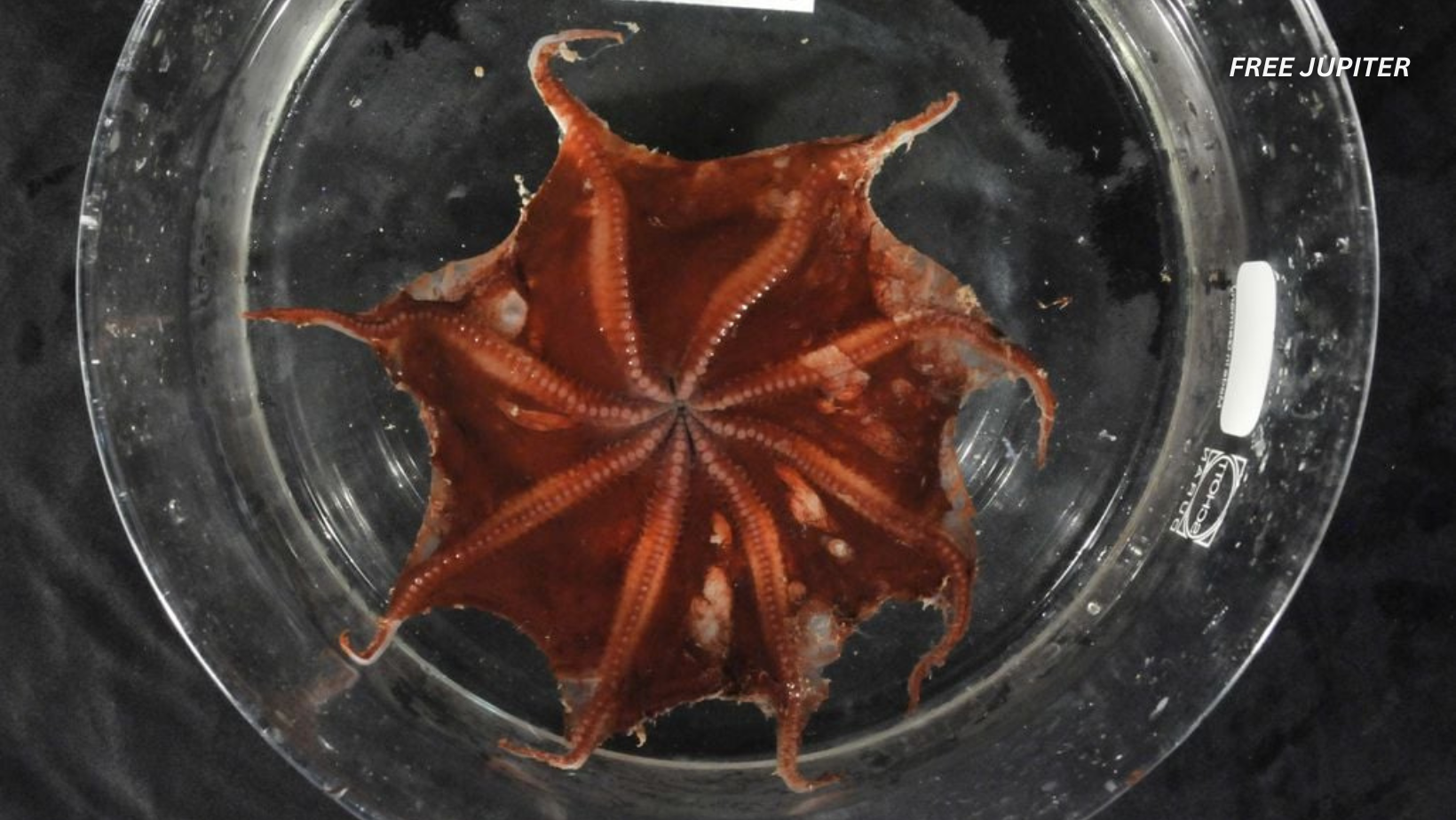Friendly Note: FreeJupiter.com shares general info for curious minds 🌟 Please fact-check all claims—and always check health matters with a professional 💙
Far beneath the surface of the ocean, in a place untouched by sunlight and barely known to science, something extraordinary has been found. In the stillness of the deep sea, life continues to evolve in ways few people can imagine. Strange creatures drift through the cold, pressurized darkness, their shapes and movements unlike anything seen on land. Each new discovery in these depths challenges what we think we know about survival, adaptation, and the limits of biology. Some of the ocean’s most fascinating secrets are only now beginning to surface.
In the dark waters of the Indian Ocean off Western Australia, scientists have identified a new deep-sea species that has quickly caught global attention. Named the Carnarvon flapjack octopus, or Opisthoteuthis carnarvonensis, this peculiar animal was found during a 2022 expedition in the Carnarvon Canyon Marine Park. Researchers from the Commonwealth Scientific and Industrial Research Organisation, or CSIRO, led the deep-sea mission aboard the RV Investigator. What they discovered nestled within the cold depths at over 1,000 meters below sea level was unlike any other known species of octopus. This discovery contributes to the growing understanding of marine biodiversity in Australian waters and reveals fascinating insights about life in some of the planet’s most inaccessible regions.
Meet the Carnarvon Flapjack Octopus
The Carnarvon flapjack octopus is a small, gelatinous creature measuring around 1.6 inches or 4 centimeters across. Despite its tiny size, this species stands out for its unique ability to shapeshift. It can compress its body to appear flat like a pancake or inflate itself into an umbrella-like shape. These transformations are believed to assist with camouflage and locomotion along the seafloor. Belonging to the umbrella octopus group known scientifically as Opisthoteuthis, it is a relative of the better-known dumbo octopuses. These deep-sea creatures are named after the Disney character due to the large fins on their heads that resemble elephant ears. Like its relatives, the Carnarvon flapjack octopus uses these fins to glide gently through the water in a style often described as elegant or even ghostly.
Life in the Deep Sea Trench
This newly described species was found living between 1,044 and 1,510 meters deep, or about 3,425 to 4,954 feet. At these depths, sunlight cannot penetrate, temperatures hover near freezing, and pressures can reach more than 100 times the atmospheric pressure at sea level. Organisms that survive in this environment have evolved extraordinary features to endure such extreme conditions. The Carnarvon flapjack octopus is no exception. It has relatively large eyes adapted to detect even the faintest glimmers of light. These eyes help it find prey in a habitat that offers very little visibility. Its preferred diet includes small marine worms and tiny crustaceans. These animals are caught as the octopus glides low across the ocean floor, using its webbed arms to trap food in the sediment.
Why This Octopus Matters
The discovery of the Carnarvon flapjack octopus matters for several reasons. First, it adds a new member to the Opisthoteuthis genus, expanding scientific understanding of umbrella octopuses. Second, it proves that Australia’s deep-sea zones still hold many secrets. Marine biodiversity in these remote ecosystems remains poorly understood. Identifying new species not only fills gaps in taxonomy but also helps scientists track environmental changes. Third, this octopus demonstrates the diverse adaptations animals can develop to survive under high pressure and in total darkness. Its shape-shifting behavior and gelatinous structure are examples of the incredible versatility of life.
Read More: Scientists Have Discovered A Mysterious ‘Golden Orb’ at the Bottom of the Ocean
The Role of CSIRO and RV Investigator
The team behind this discovery worked aboard the RV Investigator, a state-of-the-art research vessel operated by CSIRO’s Marine National Facility. The RV Investigator is equipped to explore Australia’s deep oceans using remotely operated vehicles, sonar mapping, and environmental monitoring equipment. During the 2022 voyage to Carnarvon Canyon Marine Park, researchers used robotic arms and deep-sea cameras to collect both video footage and physical samples. Several specimens of this new octopus species were retrieved. These were then transported to a laboratory where detailed morphological analysis began. By comparing sucker counts, body structure, fin placement, and internal organ arrangements, scientists confirmed they were observing a previously unknown species.
How Scientists Confirmed a New Species
Classifying a new species of octopus is not as simple as finding a strange-looking creature and giving it a name. It requires a rigorous set of steps to differentiate it from already known species. Researchers conducted a full anatomical study of the specimens collected. This included measuring the length and width of various body parts, analyzing the texture of the skin, and studying the number and arrangement of suckers on its arms. They also reviewed genetic data when possible, although DNA preservation can be difficult with deep-sea animals due to pressure and temperature changes. Once the team established that the physical features of the Carnarvon flapjack octopus did not match any known Opisthoteuthis species, it was officially classified and named in scientific literature.
Unique Features of the Carnarvon Flapjack Octopus
Unlike many shallow-water octopuses, the Carnarvon flapjack octopus cannot produce ink. This is common among deep-sea species, where ink would offer no real benefit in the pitch-black surroundings. It also lacks the ability to change skin color rapidly, like many of its shallow-water cousins. Instead, it relies on body shape and passive coloration to blend in. The gelatinous body and wide fin span give it the ability to glide rather than swim with quick bursts, which conserves energy in an environment where food is scarce. These fins can also flutter gently, adding to the visual camouflage by mimicking marine snow and debris that commonly floats through deep waters.
What This Discovery Means for Marine Biology
Discovering a new species of octopus, particularly one with such unique adaptations, holds immense value for the field of marine biology. It demonstrates the complexity and diversity of deep-sea ecosystems, which remain among the least explored habitats on Earth. Every new species discovered adds a piece to the larger puzzle of how life evolves and thrives under extreme conditions. It also reminds scientists and policymakers that deep-sea mining, climate change, and plastic pollution could have consequences on species not yet even known to science. Protecting unexplored marine areas has now become even more urgent.
The Importance of Carnarvon Canyon Marine Park
The region where this octopus was found, Carnarvon Canyon Marine Park, is part of a network of protected marine environments along Australia’s western coastline. These parks play a vital role in conserving fragile ecosystems, many of which include rare coral, sponge gardens, and deep-sea canyons. Marine parks are established to limit damaging human activity like bottom trawling, oil exploration, and waste dumping. The discovery of a new octopus species within the park’s boundaries highlights the value of these protected areas. It proves that preserving natural marine environments allows biodiversity to thrive, even in the deepest parts of the ocean.
How Shape-Shifting Helps Survival
The ability to alter body shape is one of the more intriguing aspects of the Carnarvon flapjack octopus. Scientists believe this helps the animal achieve neutral buoyancy and mimic various environmental textures. Flattening itself against the ocean floor may help it hide from predators, while puffing up could make it look less edible or confusing to larger animals. These behaviors have been captured on deep-sea cameras and continue to be analyzed for better understanding. This is not simply a party trick of nature. It is an advanced survival strategy in one of the harshest environments on the planet.
Public Reaction and Popular Fascination
As news of the discovery spread, images and video clips of the Carnarvon flapjack octopus captured public imagination. Its soft translucent body and fluttering ear-like fins inspired comparisons to animated characters and alien creatures. Marine biologists hope that the fascination with this species can help generate more public support for deep-sea research. Funding for such exploration often falls behind more visible environmental causes. However, the deep sea contains vast genetic resources, potential pharmaceutical compounds, and evolutionary data that could benefit multiple scientific fields.
Where the Research Goes Next
The specimens of Opisthoteuthis carnarvonensis are now part of the CSIRO Australian National Fish Collection. This repository allows researchers to conduct further studies on the morphology, behavior, and evolutionary history of the species. Future missions may also aim to capture live footage of the species in its natural habitat to understand its mating rituals, feeding behavior, and interactions with other deep-sea life. Genetic comparisons with other members of the Opisthoteuthis genus may reveal how these animals diverged over time. There is still much to learn about how this new octopus fits into the wider family tree of cephalopods.
The Broader Significance of Deep-Sea Discoveries
The ocean floor remains Earth’s final frontier. Less than 20 percent of it has been mapped in detail. Most deep-sea species remain undescribed, and many likely go extinct before they are ever discovered. Finding a new species like the Carnarvon flapjack octopus is a reminder of the wonders still hiding below the waves. It offers hope that even as the planet faces biodiversity loss on land, the ocean continues to hold surprises. It also serves as a call to protect these habitats before more damage is done. Exploration must go hand-in-hand with conservation.
Read More: Unraveling The Mystery Of The Indian Ocean’s ‘Gravity Hole’
A Tiny Octopus With a Big Impact
The discovery of the Carnarvon flapjack octopus proves that even the smallest creatures can reshape our understanding of life. Its gelatinous form, shape-shifting talents, and quiet existence in the deep sea all point to a complex evolutionary story. Thanks to the work of CSIRO scientists and their collaborators, this once-hidden species is now part of the scientific record. It is not just another deep-sea curiosity. It is a symbol of the mysteries still lurking in the dark, waiting for the light of research to find them.










